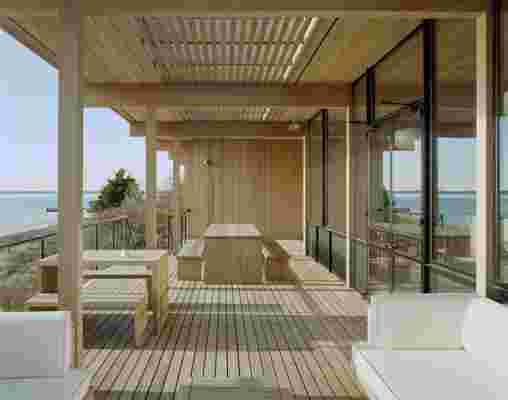When he was diagnosed with Parkinson’s disease, Cary Tamarkin remembers a friend telling him, “You’re going to see: This is going to be the best thing that ever happened to you, because it will force you to put your life in perspective.”
Tamarkin, the Manhattan architect and developer, is proving the friend right. As Tamarkin Co., the firm he started, completes the last two buildings he designed, its founder has turned his attention from architecture to painting.
“I knew I wanted to make a change,” says Tamarkin, who is 61. The Parkinson’s diagnosis, which came about eight years ago, “just made me do it sooner.”
Now he divides his time between his Manhattan loft, where a large Le Corbusier tapestry dominates the living room, and his house and studio on Shelter Island. Some of his recent canvases, abstracts painted “wet on wet,” have required continuous 12-hour sessions, usually all-nighters. “There’s no time for decision-making,” says Tamarkin, which makes the process the opposite of how he practiced architecture. “Everything,” he says, “was drawn 80 times and looked at over and over.”

"It’s so nice when you get these big fields of color," comments Tamarkin of his works, which take him anywhere from a few hours to several months to create.
Tamarkin grew up wanting to be an artist as well as a businessman. After graduating from Harvard, he worked as an architect in Boston for ten years before deciding he would “have more fun” if he developed his own buildings. He founded his firm in Manhattan in 1994 and says the dual roles allowed him to “make a little money” while doing architecture he was proud of.
The result was a group of exquisitely detailed buildings. At a time when characterless glass boxes seem to be crowding out every other kind of architecture, Tamarkin used masonry and heavy steel casement windows to make his buildings feel grounded and significant. One, 10 Sullivan Street, has become known for its flatiron shape (the “prow” is visible from the Avenue of the Americas in SoHo). Another, 508 West 24th Street, in Chelsea, has a large clock facing the High Line.
The last two in the series, both containing condos, are a conversion of a school at 555 West End Avenue, on the Upper West Side, and a new building at 550 West 29th Street.

Tamarkin's home on Shelter Island, which is emblematic of his clean-lined approach to architecture.
Tamarkin has also designed two new private residences—a house on Long Island and a Manhattan penthouse “for my ex-wife’s ex-husband,” he says—but he has organized things so that he isn’t doing the day-to-day work on the projects. He carries a flip phone, he says, precisely because he doesn’t want to be looking at construction drawings or checking emails all day.
“I’m very happy with the body of work, the way it’s going to stand up, and I have every intention of doing the same with my painting,” says Tamarkin, whose favorite artists include Brice Marden, Sean Scully, Hans Arp, Barnett Newman, and Richard Diebenkorn.
He has left the firm in the hands of its new owner (and his longtime employee), Kartik Desai, a Columbia-trained architect. Tamarkin’s wife, Lan My Do, still works at the firm as director of design. For that reason and others, he says, he is doing everything he can to help the firm succeed. Still, he hopes Desai will develop “his own MO to move the firm into the future. It’s not mine anymore.”

Leave a Reply